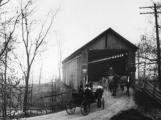1
The Women's Institutes have been the forbearers to many succeeding groups of women who have contributed to their community by addressing issues affecting their daily life.The objectives of the Women's Institutes consisted in improving the quality of life of members living in rural communities in terms of education and health, but also in terms of social and economic vitality. The first Women's Institutes gave priority to the education of women who are also mothers living on family farms.
2
The Women's Institute was founded by a woman named Adelaide Hoodless from Stoney Creek, Ontario, in 1897. The Women's Institute came into being as a response to an event in Mrs. Hoodless's life, the refusal to accept the death of her infant son after having discovered that his death was due to contaminated milk. Following this tragedy, Mrs. Hoodless vowed to dedicate the rest of her life to the education of women so that this sort of unfortunate incident would no longer be a common denominator in causing the premature death of infants. At the end of 1897 the Women's Institute of Stoney Creek counted 75 members. The Women's Institute very rapidly expanded throughout Ontario and branches began to be formed in other Canadian provinces. The majority of the members from the Women's Institute belonged to rural communities and most of them were English speaking.3
Mrs. Adelaide Hunter Hoodless and her children: Edna, Muriel and BernieCirca 1887
 Credits:
Credits:Library and Archives Canada, Federated Women's Institutes of Canada fonds (R2976-0--3-E), PA128887
4
For Home and Country'A nation cannot rise above the level of its homes, therefore women must work and study together to raise our homes to the highest possible level.'
Adelaide Hoodless, the founder of the first Women's Institute in Stoney Creek, Ontario, Canada.
5
Postcard of the Adelaide Hunter Hoodless HomesteadSt. George, Ontario, Canada
 Credits:
Credits:Eastern Townships Resource Centre, P027/015, Sherbrooke County Women’s Institutes fonds
6
Postcard of the parlour and bedroom of the Adelaide Hunter Hoodless Homestead1850-1881
St. George, Ontario, Canada
 Credits:
Credits:Eastern Townships Resource Centre, P027/018, Sherbrooke County Women’s Institutes fonds
7
Federated NewsJanuary 1947
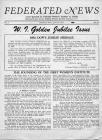 Credits:
Credits:Federated News, vol. 1, no. 20, January 1947, p. 1
Eastern Townships Resource Centre, P027, Sherbrooke County Women’s Institutes fonds
8
Federated NewsJanuary 1947
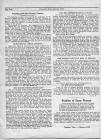 Credits:
Credits:Federated News, vol. 1, no. 20, January 1947, p. 4
Eastern Townships Resource Centre, P027, Sherbrooke County Women’s Institutes fonds
9
Women's Institute memorabilia plate1997
 Credits:
Credits:Private Collection of Gwen Parker
Photograph by Chloe Southam
10
Striving for betterment'Women's Institute aims to raise the standard of homemaking, maintain the national tradition of handicrafts, promote education particularly in rural areas, improve the welfare of child and health of the public, teach Canadian Citizenship, have a true spirit of patriotism, promoting world unity and international understanding.'
Jane C. Pearson, comp., and Wendy Lessard, ed., A Brief History of Womens Organizations in Lennoxville, Lennoxville, Bishops University, 1974, p. 5.
11
The historical region of the Eastern Townships is a territory located south of the St. Lawrence River, between the Richelieu and Chaudière Rivers. The term 'township' refers to a division of space used by the British colonial administration to concede territory and consists of a square tract of land with sides measuring 16.6 km. With the arrival of the first Loyalist families around the Missisquoi Bay in the 1780s and the settlement of New England pioneers in search of good lands at the turn of the century, the Eastern Townships were opened to a population of American descent. The War of 1812 abruptly stopped this movement of population. When it resumed after 1820, the movement of migration coming from the United States was matched by another coming from the British Isles. Indeed, after 1815, families arriving from England, Scotland and Ireland began to settle in the region. Even though a few Francophone families established themselves in the area in the first half of the 19th century, most of the Eastern Townships were then populated by English-speaking communities of American and British descent. Hence, a society showing original traits, influenced by the culture of New England, developed in the Eastern Townships and is now part of this region's heritage even though the proportion of Francophones and Anglophones in the region has now been reversed.In the 19th century, the Eastern Townships witnessed the development of thriving agriculture that gradually opened to the market. Here, the turn toward livestock farming was taken earlier than in other regions of the province and the Townships are the cradle of Quebec cheese industry. Industrial activities also developed during this period, including the cotton industry, the fabrication of paper out of wood pulp, as well as the exploitation of copper, granite and asbestos deposits. Small and dynamic urban centres were created, often located around mills exploiting the rich waterpower of the region's many rivers, and linked together by an extensive network of roads and railroads.
12
Map of the Eastern Townships1928
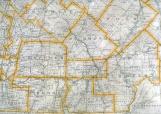 Credits:
Credits:Eastern Townships Resource Centre, OL Map Cabinet
Canada, Department of the Interior, 'Quebec and Montreal Sheet', 1928
13
Eastern Townships county and township boundaries1939
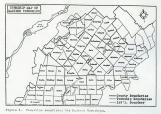 Credits:
Credits:Jean I. Hunter, The French Invasion of the Eastern Townships: A Regional Study, Master's Thesis, McGill University, 1939, figure 2
